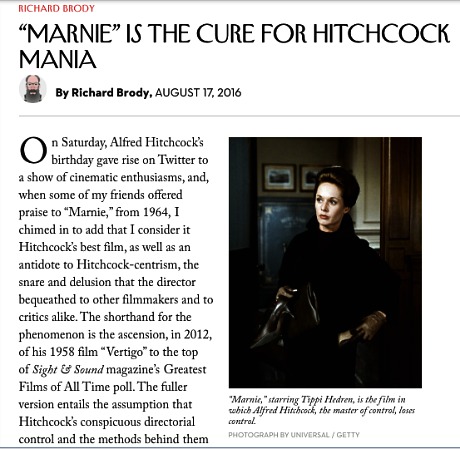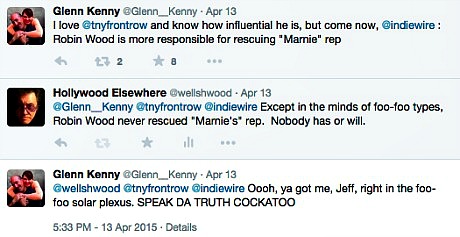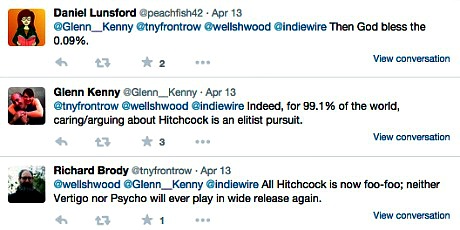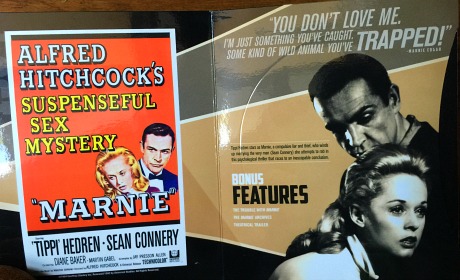August is generally a slow time for movie columnists. I therefore understand why New Yorker critic-essayist Richard Brody posted an 8.17 essay about the wonder of Alfred Hitchcock‘s Marnie (’64), which I regard as Hitchcock’s worst by a country mile. Last year I posted two essays that argued with Brody’s astounding thesis that Marnie is, in fact, Hitchcock’s best. (The first appeared on 4.16.15, the second on 7.23.15.) I’ve nothing to add but Brody’s latest Marnie essay can’t go unchallenged.

“Don’t Marnie Me,” 4.15.15: “Three days ago I nearly fell out of my chair when I noticed a Twitter dispute among some Alfred Hitchcock devotees (including occasional HE gadfly Glenn Kenny) about who had been more influential in restoring the reputation of Hitchcock’s Marnie — New Yorker contributor-columnist Richard Brody (a.k.a., tinyfrontrow) or the late Robin Wood, whose fascinating interpretations in his 1965 book “Hitchcock’s Films” did a lot to advance the belief that Hitchcock was a major mainstream artist.
“Given that Marnie is still a ghastly thing to sit through (I tried doing so a couple of years ago), I wasn’t aware that Marnie‘s reputation had ever been restored. But that’s the foo-foo crowd for you, encamped and gathering firewood on their own tight little island.


The vast majority of Hitchcock fans live on the mainland, of course, and in so doing regard Marnie as an intermittently interesting but mostly dull and actually quite grotesque film for the most part — Hitchcock’s first major misfire since Under Capricorn and perhaps even his all-time worst movie. Even the sometimes awful Torn Curtain, which I had trouble re-watching when the Hitchcock Bluray box set came out two or three years ago, is better than Marnie.
The Birds was the end of Hitchcock’s glorious 14-year run which began with 1951’s Strangers on a Train — Marnie signalled the beginning of the downturn.
Marnie is plagued by an initially intriguing but finally quite dull lead character (augmented by a chilly, constipated performance by Hedren), and by oppressively slow pacing, expositional on-the-nose dialogue, a tedious psychological scheme and some truly atrocious visual effects (hokey matte paintings, gruesome rear-screen projections and some kind of sexual or menstrual bloodbucket freak-out effect that has to be seen to be believed).
A drama about the fetishy manipulation of a somewhat icy, psychologically screwed-up femme fatale, Marnie was as much of a “personal” Hitchcock film as Vertigo (’58), which dealt with similar characters and themes. Marnie‘s basic story, about a frigid kleptomaniac (Tippi Hedren ) being blackmailed into sex and marriage by an ex-boss (Sean Connery ), reflected Hitchcock’s relationship with Hedren, whom he groomed and controlled and tried to sexually access between the making of The Birds and Marnie in late ’62, ’63 and ’64.
Connery’s Mark Rutland, obsessed with Hedren’s Marnie, uses the threat of informing the authorities about her larcenous history to force her to marry him, even though he also has a semblance of tender feelings for her, just as Hitchcock threatened to torpedo Hedren’s career if she didn’t put out.
I’ve always believed that Marnie feels fake, flat, strained and labored because Hitchcock himself was emotionally off-balance, torn between secretive lust and his often dazzling directorial technique, when he shot it. I’m sure he thought he knew what he was doing when he made Marnie, but deep down I don’t think he knew which end was up. The much-written-about fact that he was invested with “having” Hedren means that he must have felt enraged and probably disoriented when he realized his efforts wouldn’t come to anything.
Wood, who died in ’09, makes one of his points on “The Trouble With Marnie,” a 2000 Laurent Bouzereau documentary contained on the Bluray.
Wood claimed that Marnie‘s ludicrous visual effects “can be defended if one notes the roots of the film in German Expressionism,” according to the Marnie Wiki page. “Very early on when he started making films, [Hitchcock] saw Fritz Lang‘s German silent films, [and] was enormously influenced by that, and Marnie is basically an expressionist film in many ways. Things like scarlet suffusions over the screen, back-projection and backdrops, artificial-looking thunderstorms — these are expressionist devices and one has to accept them. If one doesn’t accept them then one doesn’t understand and can’t possibly like Hitchcock.”
Except before Marnie Hitchcock never went all German expressionist on his audience. With pretty much every film from The Birds on back to his 1920s and ’30s British period, everything he shot was more or less in the language of “realism,” or at least realism as far as he (or the technology of the day) was able to reconstruct it. I think Hitch allowed the influences of Fritz Lang to run the show when he was shooting and cutting Marnie in order to convey what must have felt to him like an unreal emotional episode — pining for an icy blonde actress who wouldn’t even give him a handjob and going half-crazy because of this…a world-class director reduced to the status of rejected schoolboy or, worse, that of a dirty old man who had failed to behave in an appropriate manner.













